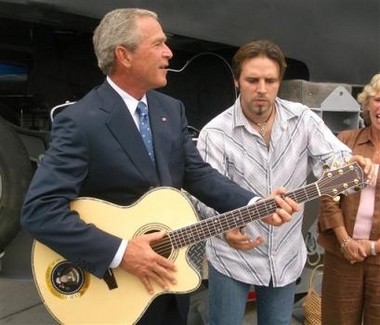
White House Knew of Levee's Failure on Night of Storm
WASHINGTON, Feb. 9 — In the aftermath of Hurricane Katrina, Bush administration officials said they had been caught by surprise when they were told on Tuesday, Aug. 30, that a levee had broken, allowing floodwaters to engulf New Orleans.
But Congressional investigators have now learned that an eyewitness account of the flooding from a federal emergency official reached the Homeland Security Department's headquarters starting at 9:27 p.m. the day before, and the White House itself at midnight.
The Federal Emergency Management Agency official, Marty Bahamonde, first heard of a major levee breach Monday morning [August 29th]. By late Monday afternoon, Mr. Bahamonde had hitched a ride on a Coast Guard helicopter over the breach at the 17th Street Canal to confirm the extensive flooding. He then telephoned his report to FEMA headquarters in Washington, which notified the Homeland Security Department.
"FYI from FEMA," said an e-mail message from the agency's public affairs staff describing the helicopter flight, sent Monday night at 9:27 to the chief of staff of Homeland Security Secretary Michael Chertoff and recently unearthed by investigators. Conditions, the message said, "are far more serious than media reports are currently reflecting. Finding extensive flooding and more stranded people than they had thought — also a number of fires."
Michael D. Brown, who was the director of FEMA until he resigned under pressure on Sept. 12, said in a telephone interview Thursday that he personally notified the White House of this news that night, though he declined to identify the official he spoke to.
White House officials have confirmed to Congressional investigators that the report of the levee break arrived there at midnight, and Trent Duffy, the White House spokesman, acknowledged as much in an interview this week, though he said it was surrounded with conflicting reports.
[]
Eyewitness to Devastation
As his helicopter approached the site, Mr. Bahamonde testified in October, there was no mistaking what had happened: large sections of the levee had fallen over, leaving the section of the city on the collapsed side entirely submerged, but the neighborhood on the other side relatively dry. He snapped a picture of the scene with a small camera.
[]
[I]nvestigators have found the e-mail message referring to Mr. Bahamonde's helicopter survey that was sent to John F. Wood, chief of staff to Secretary Chertoff at 9:27 p.m. They have also found a summary of Mr. Bahamonde's observations that was issued at 10:30 p.m. and an 11:05 p.m. e-mail message to Michael Jackson, the deputy secretary of homeland security. Each message describes in detail the extensive flooding that was taking place in New Orleans after the levee collapse.
Given this chain of events, investigators have repeatedly questioned why Mr. Bush and Mr. Chertoff stated in the days after the storm that the levee break did not happen until Tuesday, as they made an effort to explain why they initially thought the storm had passed without the catastrophe that some had feared.

Picture caption: A photo taken by a federal emergency official the day Hurricane Katrina arrived [Monday, August 29, 2005] showed the broken 17th Street Canal levee in New Orleans.






No comments:
Post a Comment